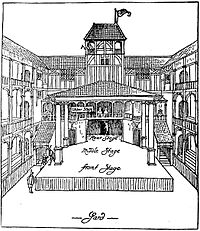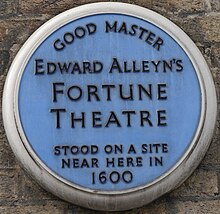Fortune Playhouse
| The Fortune | |

|
|
| location | |
| Address: | Golding Lane (now Golden Lane) |
| City: | London EC1Y |
| Coordinates: | 51 ° 31 '22 " N , 0 ° 5' 39" W |
| Architecture and history | |
| Opened: | 1600 |
| Spectator: | 2340 seats |
| Architect: | Peter Street (contractor) |
| Named after: | of the Roman goddess Fortuna (1600) |
| Deposed in 1661 | |

The Fortune Playhouse or Fortune Theater was a theater in London . It existed from 1600 to 1642 (to a very limited extent until 1661) and must not be confused with the theater of the same name that opened in London's West End in 1924 .
history
On the cusp of the 17th century, the building contractor Peter Street was commissioned by impresario Philip Henslowe , who had already successfully run The Rose in Southwark , and his son-in-law and most famous actor of his time, Edward Alleyn, to build a new theater in north London. It was supposed to compete with the famous Globe Theater , which was also located in Southwark. The agreed price was £ 520 .
The theater was named after the Roman goddess Fortuna , whose statue also adorned the front entrance.
The historically handed down contract for the construction of the Fortune Theater contains precise information about the building project for the carpenters, but reference is made throughout to the construction conditions of the Globe Theater , which was completed a year earlier , without describing them in more detail, so that from today's Numerous ambiguities exist. The native Londoners, on the other hand, were familiar with the theater and architecture of the Globe ; more detailed descriptions were therefore not necessary in the contract, especially since the rebuilding of Globe 1599 was under the direction of Streetes.
From 1600 to 1621, Alleyn's drama company The Admiral's Men , later renamed Prince Henry's Men and Elector Palatine's Men , were the main rivals of Shakespeare's theater group Lord Chamberlain's Men .
Although the stage corresponded to that of the Globe Theater , the external shape of the house, in contrast to all other public theaters - possibly following the model of private theaters - was square instead of round. The contract of 1600 between Alleyn and Henslowe not only provides information about the construction of the Fortune Theater , but is also one of the essential documented sources of information about the size, construction and audience capacity of the large popular stages of the Elizabethan theater as a whole.
The external dimension of the Fortune Theater with its three spectator galleries was almost 25 meters (about 80 feet ) in width, that of the yard ("yard"), the so-called pit , about 17 meters (55 feet). In this courtyard protruded the 43 feet wide and 27.5 feet deep, i. H. Platform stage ("apron stage") measuring around 13 × 8.5 to 9 meters . Around the open inner courtyard there were three-storey covered galleries that could be entered from the courtyard and through separate entrances from the outside. The theater seated around 2,340 people.
On December 9, 1621, the Fortune Theater burned down . It was reopened in March 1623 and after the ban on public performances and the closure of the popular theaters in 1642 by the Puritan London magistrate only occasionally used for secret performances. Upon the return of Charles II , the former Fortune Theater was demolished to make room for the construction of 23 houses.
A model reconstruction of the Fortune Theater was shown at the 1927 German Theater Exhibition in Magdeburg .
literature
- Manfred Brauneck , Gérard Schneilin (ed.): Theater Lexicon 1. Terms and epochs, stages and ensembles . Rowohlt Taschenbuch Verlag Reinbek near Hamburg, 5th completely revised new edition August 2007, ISBN 978-3-499-55673-9
Web links
- Fortune Theater - Historical Theater, London, United Kingdom - Entry in the Encyclopædia Britannica (English)
Individual evidence
- ↑ See Wolfgang Weiß: The Drama of Shakespeare's Time. Attempt at a description. Kohlhammer Verlag, Stuttgart et al. 1979, ISBN 3-17-004697-7 , here chapter 1.2: Die Londoner Bühnen, p. 30ff. and Chapter 1.3.1: Audience numbers and prizes, p. 49f. Cf. also Helmut Castrop: The Elizabethan Theater. In: Ina Schabert (Ed.): Shakespeare-Handbuch. Time, man, work, posterity. Kröner, 5th, reviewed and supplemented edition, Stuttgart 2009, ISBN 978-3-520-38605-2 , pp. 71–116, here pp. 84ff. See also the information in the Encyclopædia Britannica on [1] . Retrieved January 21, 2019.
- ↑ a b See the information in the Encyclopædia Britannica on [2] . Retrieved January 21, 2019.
- ↑ See the information in the Encyclopædia Britannica on [3] . Retrieved January 21, 2019. The site manager's spelling is Peter Street. See also Helmut Castrop: The Elizabethan Theater. In: Ina Schabert (Ed.): Shakespeare-Handbuch. Time, man, work, posterity. Kröner, 5th, revised and supplemented edition, Stuttgart 2009, ISBN 978-3-520-38605-2 , pp. 71–116, here p. 77.
- ↑ See Helmut Castrop: The Elizabethan Theater. In: Ina Schabert (Ed.): Shakespeare-Handbuch. Time, man, work, posterity. Kröner, 5th, reviewed and supplemented edition, Stuttgart 2009, ISBN 978-3-520-38605-2 , pp. 71–116, here p. 77, as well as Wolfgang Weiß: The Drama of Shakespeare's Time. Attempt at a description. Kohlhammer Verlag, Stuttgart et al. 1979, ISBN 3-17-004697-7 , here chapter 1.2: Die Londoner Bühnen, p. 30f. See also the information in the Encyclopædia Britannica on [4] . Retrieved January 21, 2019.
- ↑ See Helmut Castrop: The Elizabethan Theater. In: Ina Schabert (Ed.): Shakespeare-Handbuch. Time, man, work, posterity. Kröner, 5th, reviewed and supplemented edition, Stuttgart 2009, ISBN 978-3-520-38605-2 , pp. 71–116, here pp. 80f.
- ↑ See Helmut Castrop: The Elizabethan Theater. In: Ina Schabert (Ed.): Shakespeare-Handbuch. Time, man, work, posterity. Kröner, 5th, revised and supplemented edition, Stuttgart 2009, ISBN 978-3-520-38605-2 , pp. 71–116, here p. 77.
- ↑ See Wolfgang Weiß: The Drama of Shakespeare's Time. Attempt at a description. Kohlhammer Verlag, Stuttgart et al. 1979, ISBN 3-17-004697-7 , here chapter 1.2: Die Londoner Bühnen, p. 30ff. and Chapter 1.3.1: Audience numbers and prizes, p. 49f. Cf. also Helmut Castrop: The Elizabethan Theater. In: Ina Schabert (Ed.): Shakespeare-Handbuch. Time, man, work, posterity. Kröner, 5th, reviewed and supplemented edition, Stuttgart 2009, ISBN 978-3-520-38605-2 , pp. 71–116, here pp. 84ff. See also the information in the Encyclopædia Britannica on [5] . Retrieved January 21, 2019.
- ↑ Official catalog of the German Theater Exhibition Magdeburg 1927, No. 1007 (p. 105) with explanatory text. According to Keller, the model was in the Deutsches Theatermuseum in Munich in 1930 . Other sources locate the exhibits from the 1927 exhibition in the Theatermuseum Berlin
- ↑ Shakespeare Yearbook , Volume 66 by Wolfgang Keller , 1930

